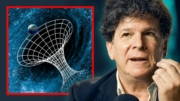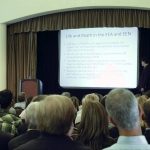
WHAT SCIENTIFIC IDEA IS READY FOR RETIREMENT?
M-theory / String Theory is the Only Game in Town
If one views science as an economist, it would stand to reason that the scientific theory that should be first retired would be the one that offers the greatest opportunity for arbitrage in the market place of ideas. Thus it is not sufficient to look for ideas which are merely wrong, as we should instead look for troubled scientific ideas that block progress by inspiring zeal, devotion, and what biologists politely term ‘interference competition’ all out of proportion to their history of achievement. Here it is hard to find a better candidate for an intellectual bubble than that which has formed around the quest for a consistent theory of everything physical, reinterpreted as if it were synonymous with ‘quantum gravity’. If nature were trying to send a polite message that there is other preliminary work to be done first before we quantize gravity, it is hard to see how she could send a clearer message than dashing the Nobel dreams for two successive generations of Bohr’s brilliant descendants.
To recall, modern physics rests on a stool with three classical geometric legs first fashioned individually by Einstein, Maxwell, and Dirac. The last two of those legs can be together retrofitted to a quantum theory of force and matter known as the ‘standard model’, while the first stubbornly resists any such attempt at an upgrade, rendering the semi-quantum stool unstable and useless. It is from this that the children of Bohr have derived the need to convert the children of Einstein to the quantum religion at all costs so that the stool can balance.
But, to be fair to those who insist that Einstein must be now made to bow to Bohr, the most strident of those enthusiasts have offered a fair challenge. Quantum exceptionalists claim, despite an unparalleled history of non-success, that string theory (now rebranded as M-theory for matrix, magic or membrane) remains literally ‘the only game in town’ because fundamental physics has gotten so hard that no one can think of a credible alternate unification program. If we are to dispel this as a canard, we must make a good faith effort to answer the challenge by providing interesting alternatives, lest we be left with nothing at all.
My reason for believing that there is a better route to the truth is that we have, out of what seems to be misplaced love for our beloved Einstein, been too reverential to the exact form of general relativity. For example, if before retrofitting we look closely at the curvature and geometry of the legs, we can see something striking, in that they are subtly incompatible at a classical geometric level before any notion of a quantum is introduced. Einstein’s leg seems the sparest and sturdiest as it clearly shows the attention to function found in the school of ‘intrinsic geometry’ founded by the German Bernhard Riemann. The Maxwell and Dirac legs are somewhat more festive and ornamented as they explore the freedom of form which is the raison d’etre for a more whimsical school of ‘auxiliary geometry’ pioneered by Alsatian Charles Ehresmann. This leads one naturally to a very different question: what if the quantum incompatibility of the existing theories is really a red herring with respect to unification and the real sticking point is a geometric conflict between the mathematicians Ehresmann and Riemann rather than an incompatibility between the physicists Einstein and Bohr? Even worse, it could be that none of the foundations are ready to be quantized. What if all three theories are subtly incomplete at a geometric level and that the quantum will follow once, and only once, all three are retired and replaced with a unified geometry?
If such an answer exists, it cannot be expected to be a generic geometric theory as all three of the existing theories are each, in some sense, the simplest possible in their respective domains. Such a unified approach might instead involve a new kind of mathematical toolkit combining elements of the two major geometric schools, which would only be relevant to physics if the observed world can be shown to be of a very particular subtype. Happily, with the discoveries of neutrino mass, non-trivial dark energy, and dark matter, the world we see looks increasingly to be of the special class that could accommodate such a hybrid theory.
One could go on in this way, but it is not the only interesting line of thinking. While, ultimately, there may be a single unified theory to summit, there are few such intellectual peaks that can only be climbed from one face. We thus need to return physics to its natural state of individualism so that independent researchers need not fear large research communities who, in the quest for mindshare and resources, would crowd out isolated rivals pursuing genuinely interesting inchoate ideas that head in new directions. Unfortunately it is difficult to responsibly encourage theorists without independent wealth to develop truly speculative theories in a community which has come to apply artificially strict standards to new programs and voices while letting M-theory stand, year after year, for mulligan and mañana.
Established string theorists may, with a twinkle in the eye, shout, ‘predictions!’, ‘falsifiability!’ or ‘peer review!’ at younger competitors in jest. Yet potentially rival ‘infant industry’ research programs, as the saying goes, do not die in jest but in earnest. Given the history of scientific exceptionalism surrounding quantum gravity research, it is neither desirable nor necessary to retire M-theory explicitly, as it contains many fascinating ideas. Instead, one need only insist that the training wheels that were once customarily circulated to new entrants to reinvigorate the community, be transferred to emerging candidates from those who have now monopolized them for decades at a time. We can then wait at long last to see if ‘the only game in town’, when denied the luxury of special pleading by senior boosters, has the support from nature to stay upright.
This essay was originally published in 2014 at https://www.edge.org/response-detail/25547








